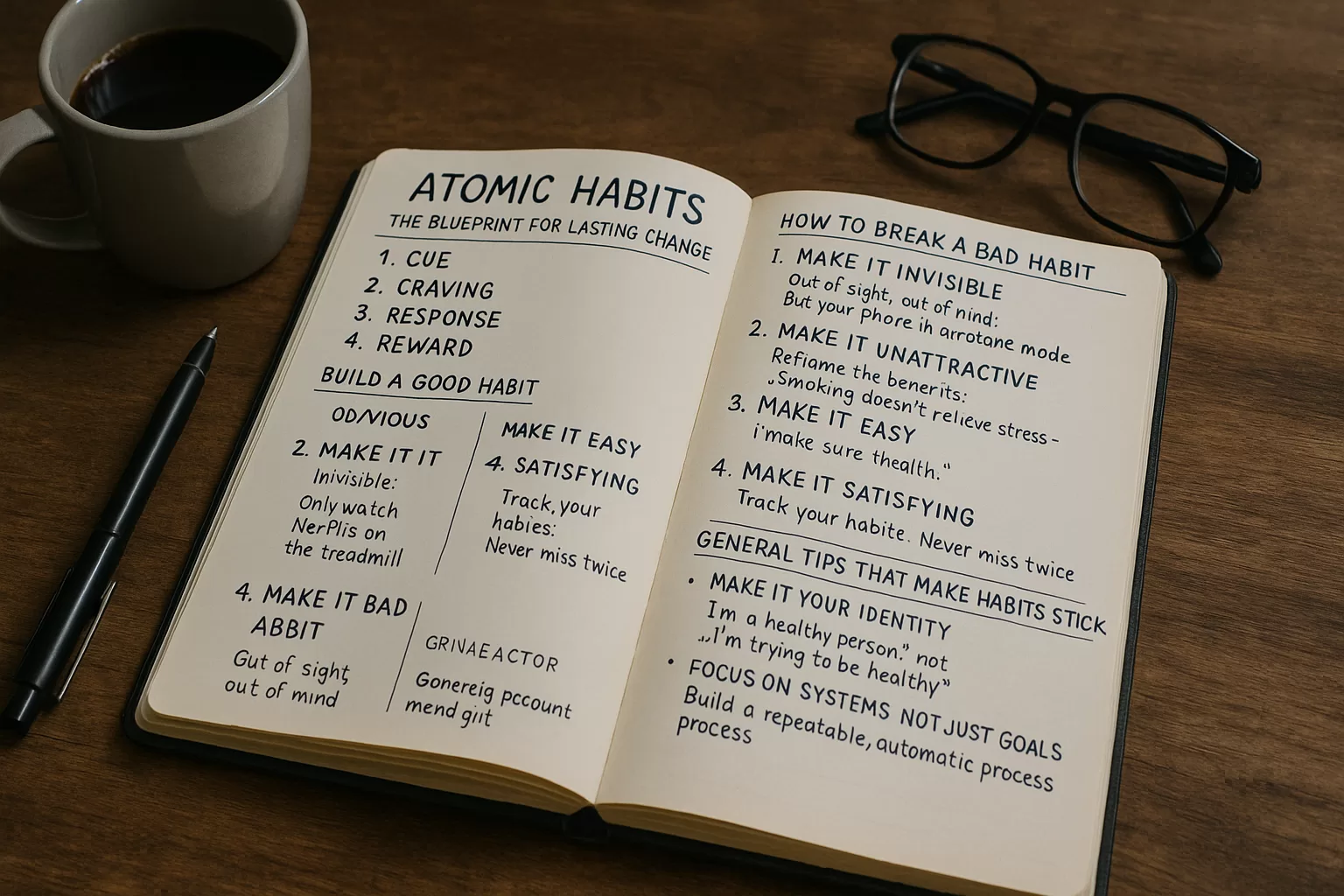Why small changes make a big difference – and how to start applying them today
We all want to improve. We want to build better habits—eat healthier, get more focused, stop procrastinating, and grow our business or personal life. But willpower fades, motivation comes and goes, and big goals can feel overwhelming.
That’s where Atomic Habits by James Clear comes in. It’s not about huge overnight transformation. It’s about mastering the art of tiny changes that compound over time.
This guide breaks down the key insights from Clear’s framework and gives you real-world examples to start applying them today.
The 4 Laws of Behavior Change
Habits are built (or broken) through a loop of four stages:
-
Cue – the trigger that starts the behavior
-
Craving – the desire or motivation behind the behavior
-
Response – the actual behavior or action
-
Reward – the outcome that satisfies the craving and reinforces the behavior
To build a good habit, make it:
-
Obvious
-
Attractive
-
Easy
-
Satisfying
To break a bad habit, reverse the laws:
-
Make it Invisible
-
Make it Unattractive
-
Make it Difficult
-
Make it Unsatisfying
How to Build a Good Habit
1. Make It Obvious
-
Verbalize it: “I want to get healthier, but I always reach for snacks at 3pm.”
-
Write down your habits: List daily routines and mark what’s helping or hurting.
-
Implementation intention: “I will [habit] at [time] in [location].”
-
Example: “I will work out at 7AM at the office gym.”
-
-
Habit stacking: Tie a new habit to an existing one.
-
Example: “After pouring my morning coffee, I’ll meditate for 1 minute.”
-
-
Change your environment:
-
Want to practice guitar? Leave it in the living room, not under the bed.
-
2. Make It Attractive
-
Temptation bundling: Pair something you enjoy with a new habit.
-
Only watch Netflix while on the treadmill.
-
-
Social reinforcement:
-
Surround yourself with people who already live the habit.
-
Join a fitness class, a business mastermind, or a peer accountability group.
-
-
Motivation rituals:
-
Do something energizing before a hard task.
-
Listen to pump-up music before a cold call sprint.
-
3. Make It Easy
-
Repetition beats planning: Don’t overthink it—start doing.
-
Prep in advance:
-
Want to jog in the morning? Lay out your shoes and clothes the night before.
-
-
Two-minute rule:
-
Scale the habit down: “Read 1 page” instead of “Read for 30 minutes.”
-
-
Commitment device:
-
Buy smaller plates to eat less. Or adopt a dog to force daily walks.
-
-
Automate:
-
Use tech to lock in habits—calendar reminders, savings auto-transfers, AI agents for task follow-up.
-
4. Make It Satisfying
-
Immediate rewards:
-
Skip a beer, and move $10 into a vacation fund.
-
-
Track your habits:
-
Use a calendar, app, or journal—aim for “never miss twice.”
-
-
Choose the right difficulty:
-
Bored? It’s too easy. Stuck? It’s too hard. Adjust accordingly.
-
-
Do what you like:
-
Don’t force yourself to run if you hate running. Love hiking? Start there.
-
How to Break a Bad Habit
1. Make It Invisible
-
Out of sight, out of mind:
-
Put your phone in airplane mode or in another room to reduce distractions.
-
2. Make It Unattractive
-
Reframe the benefits:
-
“Smoking doesn’t relieve my stress—it ruins my health and energy.”
-
3. Make It Difficult
-
Add friction:
-
Have someone else reset your social media password so you have to ask for it.
-
4. Make It Unsatisfying
-
Get an accountability partner:
-
We hate disappointing others more than ourselves.
-
General Tips That Make Habits Stick
The Power of Compounding
-
1% improvement daily = 37x better in a year.
-
Don’t chase intensity; chase consistency.
Make It Your Identity
-
Say: “I’m a healthy person,” not “I’m trying to be healthy.”
-
Focus on becoming the type of person who would naturally do the habit you want to form.
Focus on Systems, Not Just Goals
-
You don’t rise to your goals—you fall to your systems.
-
The goal is to build a repeatable, automatic process that supports the outcome you want.
Final Thought: You’re One Habit Away
Your current habits are perfectly designed to give you your current results.
If you want different results—more productivity, better health, less stress, or a growing business—it starts with small, deliberate changes.
Pick one habit. Apply these principles. Then stack another.
That’s how transformation happens.



